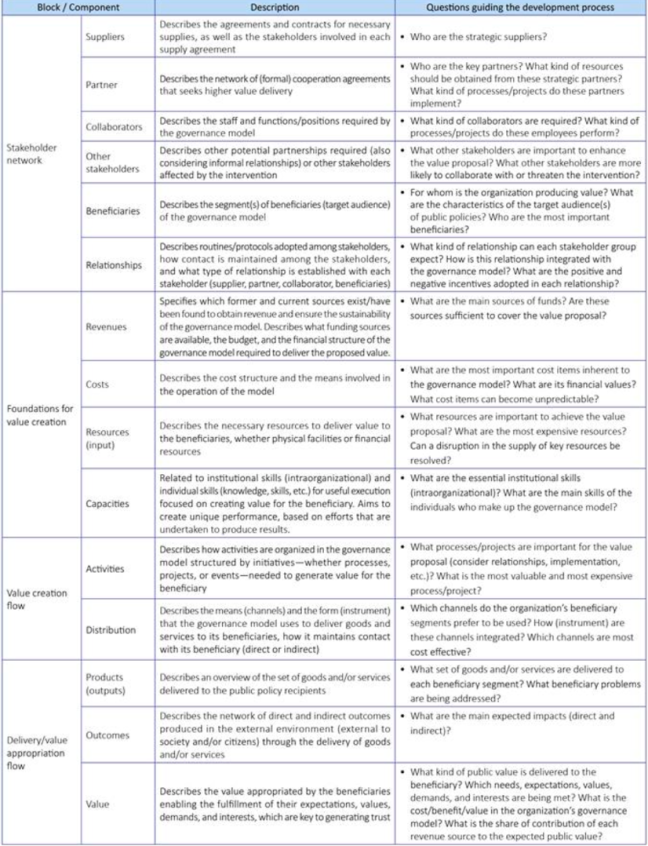| User Journey | Step 1 | Step 2 | Step 3 | Step 4 | Step 5 | Step 6 | Step 7 | Step 8 | Step 9 | Step 10 | Step 11 | Step 12 | |
| < Back | Next > |
The Business Model is the 7th step for the responsible use of DTs in PAs. Its creation refers to the identification of which concepts and tools are necessary to assist managers and involved roles in the process to understand the organisation´s logic in the process of DT adoption, how it works and how it can create value to their stakeholders. Although in the private sector it refers to the company´s logic of earning money and their segments and customers, in the public sector the business model needs to assume a different approach that complies with its main goal – create public value (as presented in the introduction of this chapter concerning the internal and external environment.
Martins (2011) presents the governance process elements that needs to be considered when developing the business model:

Regarding the institutional capacities and qualities, the object refers to the leadership, internal competencies, readiness to act, and institutional design of the public administration (or government). The collaboration refers to the collaboration between public and private actors in co-producing services and interactions with society. The performance relates to the efforts towards the achievement of the outcomes, including the efficiency, efficacy, and effectiveness of the execution and economicity of the process. Finally, the public value, as the key element of the governance process, represents the value that citizens attribute to the public service delivery and policies affecting them[1].
Based on the contribution from Martins (2011) and an extensive literature review, Martins et al (2019) elaborated a public governance canvas (Figure 13), which is here assumed to be best suitable for the intentions of providing an overview of the process of DT use in the public sector.

Figure 14 describes each of the processes to be described in the canvas:

In this sense, the business model for public administrations would work in the same logic as the business model for private organisations, but with the specificity of not aiming at creating profit, but good public services return. Hence, the representation of the applicability of a disruptive technology in public administrations for the response to public needs is done through a business model that includes: the identification of partnerships and collaboration for the development or deployment of a disruptive technology; the stakeholders involved in the development or deployment of the application stream in PAs; the establishment of suppliers; the measurement of internal capacities and resources; the activities to be led for the successful implementation of a DT; attached costs for the implementation; the expected outputs of the implementation and scaling of the distribution of the solution; the main beneficiaries of the solution; expected outcomes of the implementation; and finally, the added value.
For further information, consult the Guidelines for preparing a business development plan.
| Roles Involved at this stage | Activity to be carried out | ETAPAS tools that can support the activity | |
|---|---|---|---|
| Research team | Develop the business model based on previous findings. | Guidelines for preparing a business development plan. | |
| Specific expert of the DT adopted | Give further support concerning the specificities of the DT, if needed. | Guidelines for preparing a business development plan. | |
| Financial of procurement advisor | Lead the resources and revenues stream analysis and reporting. | Guidelines for preparing a business development plan. | |
| Process manager | Validation. |
[1] Martins, H. F. Um composto de governança pública. Revista Governança Social IGS, Belo Horizonte, ano 4, ed. 10, May/July 2011.
[2] Martins et al. “Business model in the public domain: the public governance canvas”. Cadernos EBAPE.BR, vol 17, no.1, pp. 49-67, 2019.
| < Back | Next > | ||||||||||||
| User Journey | Step 1 | Step 2 | Step 3 | Step 4 | Step 5 | Step 6 | Step 7 | Step 8 | Step 9 | Step 10 | Step 11 | Step 12 |

